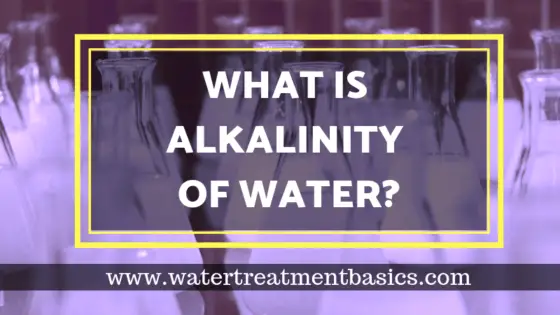Alkalinity of Water Definition:
Alkalinity of water means acid neutralization capacity of water. When you add acid in water (adding H+ ions) water absorbs H+ ions without showing significant change in pH.
Mainly, it is due to carbonate, bicarbonate & hydroxide ion present in water or the mixture of two ions present in water. The possibility of OH– and HCO3– ions together is not possible since they combine together to form CO3-2 ions.
OH– + HCO3– ⇒ CO3-2 + H2O
Types of Alkalinity:
Two types of Alkalinity present in water,
- P-Alkalinity also called Phenolphthalein Alkalinity because Phenolphthalein indicator used for analysis
- M-Alkalinity also called Methyl orange Alkalinity because Methyl orange indicator used for analysis
In alkalinity analysis different ions can be estimated separately by doing titration process in two steps.
First step: Titration of water done with standard acid solution using phenophthalien indicator & end point gives color change from pink to colorless. This is called P-Alkalinity of water.
Second Step: The same water is titrated against standard acid solution using methyl orange indicator this gives the color change from yellowish orange to brick red.
Below reaction occurs during analysis:
- OH– + H+ ⇒ H2O
- CO3-2 + H+ ⇒ HCO3–
- HCO3– + H+ ⇒ H2O + CO2
Basically, the neutralization reaction up to phenolphthalein end point shows the completion of reactions (1) and (2) only.
The amount of acid used thus corresponds to complete neutralization of OH– plus half neutralization of CO3-2.
The titration of water sample using methyl orange indicator marks the completion of the reactions (1), (2) and (3).
Based on above three reaction,
Alkalinity Relationship:
| P-Alkalinity | Total Hydroxide + 1/2 Carbonate |
| M-Alkalinity | (Total Hydroxide + 1/2 Carbonate) +1/2 Carbonate + Total Bicarbonate |
Alkalinity Calculation Table:
| ION | P = 0 | P = 1/2M | P > 1/2M | P < 1/2M | P = M |
|---|---|---|---|---|---|
| OH– | 0 | 0 | 2P-M | 0 | M |
| CO3-2 | 0 | M | 2(M-P) | 2P | 0 |
| HCO3– | M | 0 | 0 | M-2P | 0 |
Alkalinity Table Summary:
1. Phenolphthalein alkalinity (P) = 0;
It means the volume of acid used till the completion of reaction (1) and (2) is 0. This can only happen when both OH– and CO3-2 ions are not present in water.
Alkalinity is present due to HCO3– ion only which can be determined using methyl orange indicator and called methyl orange alkalinity (M).
2. P = ½ M;
Indicates that only CO3-2 ions are present. Using phenolphthalein indicator neutralization reaches up to HCO3– but using methyl orange indicator the complete neutralization of HCO3– takes place.
3. P > ½M;
It implies OH– ions are also present along with CO3-2 ions. Up to phenolphthalein alkalinity OH– ions will be neutralized completely whereas CO3-2 will be neutralized up to HCO3– ion.
But using methyl orange indicator HCO3– will be completely neutralized along with OH– and CO3-2.
4. P < ½ M;
This indicates that beside CO3-2 ions HCO3– ions are also present. The volume of acid required for the neutralization up to phenolphthalein end point correspond half neutralization of CO3-2 (equation 2).
Neutralization using methyl orange indicator corresponds to HCO3– obtained from CO3-2 and HCO3– originally present in the water sample
5. P = M;
This indicates only OH– ions are present.
In conclusion, Alkalinity of water is very important parameter in boiler water treatment program. Based on alkalinity analysis we can predict the presence of free caustic as mentioned in above table. Free caustic is responsible for caustic corrosion in boiler system.
Frequently Asked Questions:
What Causes Alkalinity in Water?
Presence of Carbonate, Bicarbonate & Hydroxide ions are responsible for alkalinity in water.
How to Determine the Alkalinity of Water?
Water sample is titrated against standard hydrochloric acid or sulphuric acid solution using phenolphthalein & methyl orange indicator.
What Should be the Alkalinity in Drinking Water?
Typically alkalinity of drinking water should be around 20-250 mg/L as CaCO3.
